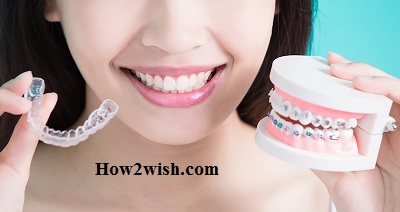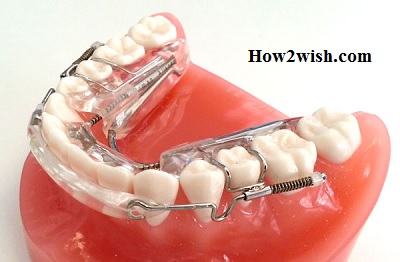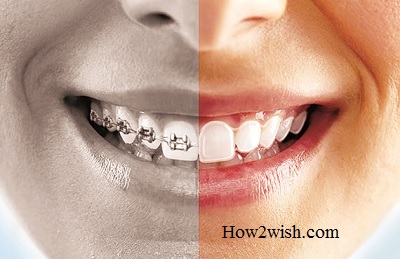What do you know about the differences between Braces or Aligners? The development of the dentition, the formation of occlusion, and other elements of the dentition – all these processes are influenced by external and internal factors that can provoke the appearance of defects. The more noticeable the deviation from the norm, the more problems it causes for patients, both from a functional and psychological point of view. Modern orthodontic treatment methods involving the installation of unique structures help correct the situation. Correction takes place without surgical intervention and allows you to restore the smile’s attractiveness. We will tell what is better to choose for teeth alignment – braces or aligners, what is the difference between the systems, and what analogs and alternatives are put instead of them – in this article.

General view
Bracket systems are a classic option used by orthodontists to correct defects in dentition since the end of the 19th century. The standard configuration is a non-removable system of locks fixed to the front or back surface of the enamel coating using an adhesive composition and holding a metal arc. The desire for the curved wire to return to its original shape creates pressure on the problematic units of the dentition, under the influence of which they gradually move in a given direction.
To adhere to the prescribed recovery protocol, it is essential to comply with the schedule of visits to the dental clinic. During the sessions, the doctor evaluates the changes that have occurred and tightens and corrects the position of the power element. The duration of the course of orthodontic treatment depends on the degree of severity of the diagnosed anomalies. It includes a rehabilitation period, during which the steel structure is replaced with retainers, excluding repeated crown displacement.
Alternative Method
A modern replacement for dental Braces or Aligners, the main advantage of which over the traditional option is to create more comfortable conditions for the patient. The elastic mouth guard, made of transparent plastic, adheres tightly to the enamel surface, creating a pressure similar to a power arc. At the same time, the pads are invisible to others and can be removed anytime without outside help, which significantly simplifies eating and observing hygiene procedures.
This method is optimal for those whose work involves regular speaking or public communication and for teenagers who are always acutely experiencing changes that can worsen their appearance. At the same time, it should be borne in mind that achieving the desired result also requires almost constant wear – at least 20-22 hours a day. In addition, the functional characteristics of polymeric correctors cause a smaller load created, limiting the list of defects to be eliminated to mild and moderate anomalies.
Indications and contraindications
The traditional comparison – which is better to put braces or aligners – usually begins with comparing medical recommendations that determine the appropriateness of choosing one of the options. Fixed structures help to cope with problems such as:
- Deviations in the development of bite.
- Dental crowding.
- Disproportionate development of the jaws.
- Incorrect position of individual crowns.
Braces or Aligners are also recommended when an impacted tooth needs to be extracted and are used in preparation for implant prosthetics. Depending on the configuration, the duration of correction varies from one and a half to three years – excluding the stage of wearing retainers.
The difference between Braces and Aligners is in the force of pressure created during the use of removable pads. Products take into account the individual features of the structure, are made in the form of a set of interchangeable kits, and help to cope with local defects, which include:
- Visually noticeable interdental gaps – trema and diastema.
- Torsion and deviation of crowns from the vertical axis.
- Shortened or excessive length of incisors.
Orthodontic correctors are also used for preparation before installing prostheses. The term depends on the complexity and location of the anomaly – the range is from eight months to two years.

Pros and cons of aligners and braces to use
Speaking about the advantages and disadvantages of each of the options, it is worth using a summary table that reflects the main points related to the treatment of dentition defects:
Task — Bracket systems — Removable mouthguards
Forecast of correction results — Approximate planning based on mechanical action characteristics — Accurate 3D visualization of changes digitally generated at the preliminary stage
Aesthetics — Visible during wearing, stand out on the enamel – except lingual models — Due to the transparent texture and snug fit, they are indistinguishable even with close contact
Convenience — Removal and installation are carried out only in clinical conditions, excluding damage to the enamel — Removed and installed by the patient independently, at any convenient time
Related issues — Ligature fasteners with constant contact can irritate the mucous tissues of the oral cavity. — Do not affect the condition of the enamel coating, diction, or diet choice, and also exclude the demineralization of crowns
Frequency of visits to the orthodontist — Every three to four weeks — Once every one and a half to two months
How to Remove Tooth Abscess and Prevent It From Returning
These characteristics indicate a noticeable superiority of modern polymer correctors made from a safe biologically compatible material, and this assessment is true for most indicators. However, if we proceed from the fact that aligners or braces are more effective and faster in terms of correcting diagnosed defects, then the key factor here is medical indications that determine the possibility of the practical application of one or orthodontic construction. In addition, the indicated nuances related to the operation of products deserve special consideration.
Wearing comfort
The configuration of bracket systems combines a large number of elements, which include retaining plates and locks, a power arc, as well as elastic or rigid ligatures. The key function is the creation of a traction force, under the influence of which the structure of the dentition changes. The resulting pressure requires a certain adaptation of the patient to new sensations – at first, many complain of discomfort, reminiscent of themselves even in a calm state. The lingual option is considered the most difficult – installation from the inside helps to win in aesthetics, but it can lead to damage to the mucous tissues of the oral cavity.
How are aligners different from braces? First of all – a smooth surface and a neat fit, thanks to which addiction is more comfortable. A little soreness associated with pressure on problem crowns will not go away, however, in general, patients experience less difficulty. It facilitates the task and awareness of the possibility of removing the corrector at any time, however, it is strongly not recommended to abuse this, since each product is designed for a certain duration of continuous wear. Otherwise, the treatment schedule may be violated, and the remaining sets of replacement products will be useless since the structure of the dentition will differ from the originally planned indicators.
Aesthetics
The aesthetic result is one of the key criteria for assessing success. This applies not only to the installation of artificial fillings, implants, and crowns but also to orthodontic correction, the purpose of which is to restore the functionality and natural attractiveness of a smile. Considering that the average duration of therapy is about 12-18 months, it is important to ensure that the patient experiences minimal discomfort during communication with others.
At first, it was meaningless to talk about whether aligners successfully replace braces in terms of aesthetics. Colorless plastic is not visible on the enamel and is not affected by dyes contained in various drinks and products, which provides a clear advantage in this indicator. However, modern models of bracket systems, made of ceramic or sapphire, with a transparent or coated with a special coating power arc, have significantly improved visual perception. You can talk about complete invisibility in the case of lingual constructions. For those diagnosed with complex jaw developmental defects, this option may be more attractive, since, all other things being equal, it greatly reduces the duration of recovery.

Efficiency
A topic that is debatable due to a large number of nuances. If we take a generalized idea of what can replace braces, an analog in the form of caps is recommended for use in situations where the identified deviations are not particularly difficult, while structures with a metal power arc can solve any orthodontic problems.
Peculiarities
The principle of operation remains the same in both cases. Due to the competent calculation of the force vector applied for the gradual displacement of individual units, the desired result is achieved. A smooth change in position eliminates damage to the ligaments that hold the crown in the alveolar socket, and the body’s ability to regenerate bone tissue against the background of resorption eliminates a return to its original position – but only if the schedule for wearing retainers is observed.
Adaptation
It usually takes 3 days to 2 weeks to get used to, but this will depend on the sensitivity and susceptibility to pain. Plus, aligners in a smooth surface and the absence of protruding elements that can cause injury in certain areas of contact. In addition, thin overlays do not affect diction, and for eating or performing hygiene procedures, it is enough to remove the corrector for a few minutes.
At what age can corrective structures be used
The cycle of formation and development of the dentoalveolar system in humans ends in older adolescence. Based on this, wearing braces is allowed only after reaching the age of 12-14, when the structure has already finally taken its shape, but at the same time remains malleable and responsive to the changes being made. From then on, the later the patient starts treatment, the longer the prescribed course will be. Separate models of aligners are also used today for the bite of children of primary school age. However, it is essential to consider individual indications obtained due to complex diagnostics.
Nutrition rules
Dietary restrictions become relevant for owners of fixed structures from the first installation day and remain until the end of the cycle. The diet while wearing braces excludes foods with a hard or sticky texture, including nuts, seeds, chewing gum, etc. Hard food should be cut into small pieces. In addition, all items containing aggressive dyes will have to be removed from the menu – starting with coffee and ending with ketchup and cherry juice.
Aligners, being removable, eliminate problems with compliance with a strict regimen. It is enough to remove the overlay before eating, and at the end of the meal – brush your teeth and return the corrector to its place.
Hygiene care
Caring for the condition of the oral cavity, timely removing the formed plaque, and preventing the development of caries, is much easier when it comes to wearing polymer products. When installing a bracket system, patients must learn new cleaning methods and acquire additional hygiene products, including irrigators, flosses, and special brushes. In addition, it must be taken into account that the fixed structure creates other areas for accumulating pathogenic bacteria, the high-quality processing of which is quite problematic.

Comparison of the cost of braces and aligners
One of the main questions that interest most clients who turn to the specialists of Dentika dental centers in Voronezh is the number of financial costs associated with the course of orthodontic correction. Practice shows that the determining factors are the duration of treatment, the degree of complexity of the defect, the choice of materials, and the manufacturer’s brand. At the same time, if we compare identical cases, the spread will not be too large. It is not worth talking in absentia about what is cheaper (or more expensive) to align teeth and correct bite – aligners or braces – it is not worth it since the price difference depends on individual factors and indications.
Analogs of corrective structures
When planning to correct problems of an orthodontic nature, it is best to consider all available options. In addition to aesthetics and comfort, the applied systems differ in essential characteristics, such as the principle and speed of displacement of specific units. The final choice should be based on preliminary diagnostics results and consider both the medical position and the wishes of the patient.
What is more effective
Individual defects – for example, tremas and diastemas, that is, interdental gaps in the upper or lower row – can be eliminated with braces or aligners and veneers. Thin onlays made of ceramic or zirconia are highly durable and aesthetically pleasing and are recommended for correcting the shape and strengthening the structure of anterior incisors.
Why you should not rush to choose a corrective system?
The level of the dental clinic and the qualifications of specialists are the key factors determining the compliance of all other indicators with modern standards. By contacting Dentika Dental Centers, you will receive high-quality service, professional advice, and several treatment options using up-to-date techniques that guarantee to achieve the desired result.

To Sum Up, What to Choose?
Timely correction of defects in dentition is a vital procedure that helps to maintain an attractive and healthy smile for many years. Choosing the appropriate method will be much easier for those who know how aligners differ from braces due to an objective assessment of all the advantages and disadvantages of the proposed orthodontic correction technologies.